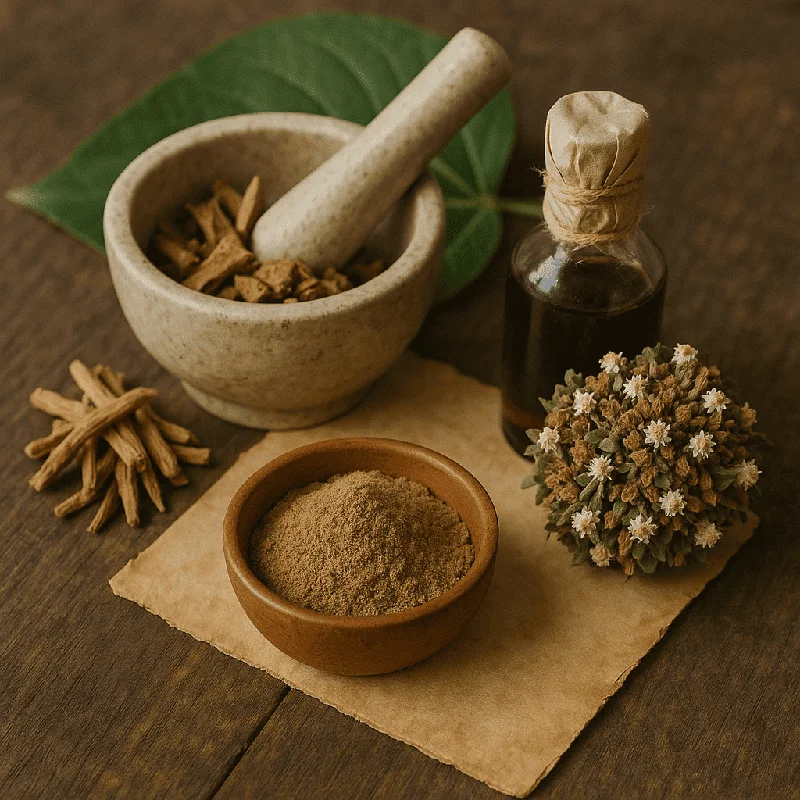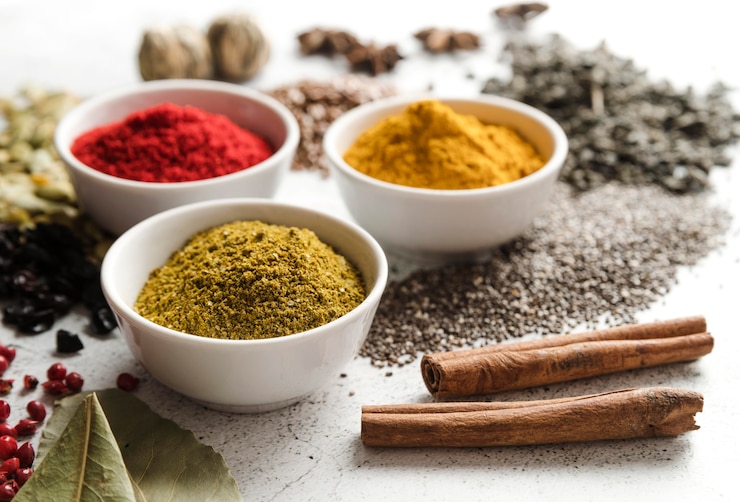Shop Now in Our Store
Nyagrodhadi Churna: An Ayurvedic Blend for Holistic Wellness

Modern healthcare increasingly appreciates the powerful synergy between traditional medicine and contemporary science. One standout remedy in Ayurvedic practice is Nyagrodhadi Churna, an herbal blend deeply rooted in ancient Indian healing traditions. But how does this churna hold up under modern scientific scrutiny? In this article, we delve into the history, composition, potential applications, and research-backed findings surrounding Nyagrodhadi Churna. We will explore the possible benefits, usage guidelines, safety profiles, and the latest peer-reviewed evidence to help you make an informed decision about its role in your healthcare routine.
What Is Nyagrodhadi Churna?
Nyagrodhadi Churna is a finely powdered herbal formulation traditionally used in Ayurveda, a holistic healing system that originated in the Indian subcontinent over 3,000 years ago. The word “Nyagrodha” refers to the banyan tree (Ficus benghalensis), one of the formulation’s primary components. Ayurvedic texts praise Nyagrodhadi Churna for its potential digestive, anti-inflammatory, and rejuvenating properties.
Ayurvedic Perspective
In classical Ayurvedic literature (e.g., the Charaka Samhita and Sushruta Samhita), Nyagrodhadi Churna is described as a combination of herbs that aim to balance the three doshas—Vata, Pitta, and Kapha. Traditional practitioners often recommend this blend for conditions associated with excess heat in the body, gastric imbalances, and generalized weakness.
Key concepts:
-
Holistic Healing: Ayurveda treats the human body as an interconnected system, where balance in digestion, metabolism, and immunity ensures optimal health.
-
Tridosha Theory: The blend’s ingredients are believed to pacify specific doshas, particularly Pitta and Kapha, depending on individual constitution.
Composition and Common Ingredients
Though the exact composition can vary slightly depending on regional and lineage-based formulations, Nyagrodhadi Churna typically contains:
-
Ficus benghalensis (Nyagrodha): Known for its anti-inflammatory and antioxidant properties.
-
Ficus racemosa (Udumbara): Traditionally used for wound healing and gastrointestinal support.
-
Ficus microcarpa (or other Ficus species): May offer cooling and soothing effects.
-
Auxiliary Herbs: Such as Shalmali (Bombax ceiba), Ashwakarna (Dipterocarpus spp.), and others that further enhance the blend’s therapeutic range.
Note: The synergy among these herbs is key in Ayurveda, emphasizing the principle that when blended in the right proportions, the herbs work more effectively than when used individually.
Potential Health Benefits
1. Digestive Health
-
Gastroprotective Properties: Some studies suggest that certain Ficus species possess gastroprotective qualities. A 2019 publication in the Journal of Ethnopharmacology reported that extracts of Ficus benghalensis may help protect the stomach lining from irritants and support healthy digestion.
-
Bowel Regularity: Traditional Ayurvedic practitioners often recommend Nyagrodhadi Churna for individuals experiencing mild constipation or irregular bowel movements.
2. Anti-Inflammatory and Analgesic Effects
-
Inflammation Control: The presence of bioactive compounds like flavonoids and tannins in Ficus benghalensiscould offer anti-inflammatory benefits.
-
Pain Relief: Preliminary animal-model research indicates potential analgesic effects, though comprehensive human studies are still underway.
3. Skin Health and Wound Healing
-
Traditional Usage: Nyagrodhadi Churna has been employed as a poultice or wash for managing minor wounds and skin irritations.
-
Scientific Backing: According to a 2020 meta-analysis in Phytotherapy Research, extracts from the banyan tree (Ficus benghalensis) have shown enhanced wound contraction rates in animal models, hinting at the formula’s potential in external applications.
4. Immunomodulatory Properties
-
Overall Wellness: Ayurveda has always emphasized the role of robust immunity in preventing diseases. Some herbal blends, including Nyagrodhadi Churna, have been studied for their immunomodulatory potential.
-
Active Compounds: Tannins, polyphenols, and flavonoids found in these plants may play a role in supporting immune response.
Scientific Evidence and Current Research
While historical usage underscores the popularity of Nyagrodhadi Churna, modern research is gradually catching up. Below are some noteworthy studies:
-
Journal of Ethnopharmacology (2019): Investigated the gastroprotective effects of Ficus benghalensis extracts, suggesting that the active phytochemicals may support gastric health.
-
Phytotherapy Research (2020): A meta-analysis highlighted the wound-healing potential of various Ficus species, providing a rationale for further human clinical trials.
-
Frontiers in Pharmacology (2021): Explored the anti-inflammatory benefits of Ayurvedic polyherbal formulations, including derivatives of banyan and related species. It underscored the complexity of synergistic compounds and the need for standardized testing.
Nevertheless, rigorous human trials are still relatively limited. Future studies with placebo-controlled, double-blind methodologies will be necessary to confirm the scope of Nyagrodhadi Churna’s efficacy and safety across diverse populations.How to Use Nyagrodhadi Churna
Dosage Guidelines
-
Traditional Recommendation: Ayurvedic practitioners typically advise around 3 to 5 grams of Nyagrodhadi Churna per day, divided into one or two doses.
-
Form of Intake: It may be mixed with warm water, milk, or a suitable adjuvant such as honey.
-
Consult a Professional: Dosage can vary based on individual constitution (Prakriti), existing conditions, and other medications. Always seek advice from a qualified healthcare provider or Ayurvedic expert.
Practical Tips
-
Start Low and Slow: If you are new to herbal supplements, begin with a lower dose and gradually increase it to observe how your body responds.
-
Combine with Lifestyle Modifications: For optimal benefits, pair your usage of Nyagrodhadi Churna with a balanced diet, regular exercise, and adequate rest.
-
Timing: Some practitioners suggest taking the churna either before meals to boost digestion or after meals to aid nutrient absorption.
Safety Profile and Possible Side Effects
Nyagrodhadi Churna is generally considered safe when used responsibly. However, as with any herbal supplement, side effects may occur:
-
Mild Gastrointestinal Discomfort: In rare instances, individuals may experience bloating or loose stools, especially when starting out or consuming higher doses.
-
Allergic Reactions: While uncommon, those allergic to any of the constituent herbs should exercise caution.
-
Interactions with Medications: Always consult a healthcare professional if you are taking prescription medications, have underlying medical conditions, or are pregnant or breastfeeding.
Incorporating Nyagrodhadi Churna in Modern Healthcare
Complementary Approach
Nyagrodhadi Churna can be integrated into a modern healthcare regimen as a complementary therapy rather than a standalone treatment. This synergy often involves:
-
Combining with Conventional Medications: Under the supervision of a qualified healthcare provider, Nyagrodhadi Churna might support recovery by contributing anti-inflammatory and antioxidant effects.
-
Preventive Health Strategy: Some practitioners advocate for its inclusion in long-term wellness plans aimed at maintaining healthy digestion and immunity.
-
Holistic Rehab Programs: In hospital settings that embrace integrative medicine, Ayurvedic formulations like Nyagrodhadi Churna can be offered alongside physiotherapy, nutritional counseling, and other rehabilitative services.
Ongoing Clinical Trials
The global shift toward integrative healthcare has led to new research initiatives exploring the impact of Ayurvedic formulations on chronic diseases such as diabetes, arthritis, and cardiovascular disorders. Though not specific to Nyagrodhadi Churna alone, these studies may soon shed further light on how multi-herbal blends can bolster conventional treatments.
Frequently Asked Questions (FAQ)
1. Can Nyagrodhadi Churna cure digestive issues completely?
No herbal remedy can guarantee a cure for all digestive problems. While some evidence suggests it may help support healthy digestion and relieve mild gastrointestinal complaints, results vary. Consultation with a healthcare provider is essential for tailored advice.
2. Is it safe for pregnant or breastfeeding women?
Pregnant and breastfeeding women should consult a qualified healthcare professional before starting Nyagrodhadi Churna or any herbal supplement. The safety profile during pregnancy and lactation has not been extensively studied.
3. How long does it take to see results?
The timeline for noticing benefits can vary among individuals, depending on factors like overall health status, dosage, and adherence to a balanced lifestyle. Some people report improvements within a few weeks, whereas others may require longer.
4. Are there any dietary restrictions while using Nyagrodhadi Churna?
While no strict dietary guidelines exist, Ayurveda often suggests avoiding overly spicy or acidic foods that could counteract the blend’s therapeutic effects. Moderation and a balanced diet can enhance the churna’s efficacy.
5. Can I use Nyagrodhadi Churna for skin disorders?
Traditional usage includes topical application for minor wounds or skin irritations. However, it is crucial to consult an Ayurvedic practitioner or dermatologist for proper assessment and guidance, especially for chronic or severe conditions.
Conclusion
Nyagrodhadi Churna stands out as a time-tested Ayurvedic blend backed by a growing body of scientific research. With potential benefits ranging from digestive support to anti-inflammatory and skin-healing properties, it offers a multifaceted approach that resonates with Ayurveda’s holistic philosophy. Modern studies, while still limited in scope, highlight the need for further exploration and standardized clinical trials to fully confirm its therapeutic potential.
If you are considering incorporating Nyagrodhadi Churna into your health regimen, remember to consult healthcare professionals, especially if you have underlying conditions or are on regular medications. As interest in integrative medicine continues to grow, solutions like Nyagrodhadi Churna underscore the importance of bridging ancient wisdom with modern science.
Disclaimer
This article is for informational purposes only and does not constitute medical advice. Always seek the guidance of a qualified healthcare professional for any questions regarding your health or a medical condition. The mentioned research and potential benefits are based on preliminary studies; individual results may vary.
Ready to Explore More?
-
Share this article with friends or colleagues who might benefit from learning about Nyagrodhadi Churna.
-
Comment below with any questions, experiences, or insights about this Ayurvedic formulation.
-
Subscribe to our newsletter for the latest updates on herbal remedies, integrative healthcare, and evidence-based wellness strategies.
By staying informed and proactively engaging in your health journey, you can make the most of both traditional wisdom and modern science for a truly comprehensive approach to well-being.
This article is checked by the current qualified Dr Sujal Patil and can be considered a reliable source of information for users of the site.
Got any more questions?
Ask Ayurvedic doctor a question and get a consultation online on the problem of your concern in a free or paid mode.
More than 2,000 experienced doctors work and wait for your questions on our site and help users to solve their health problems every day.



